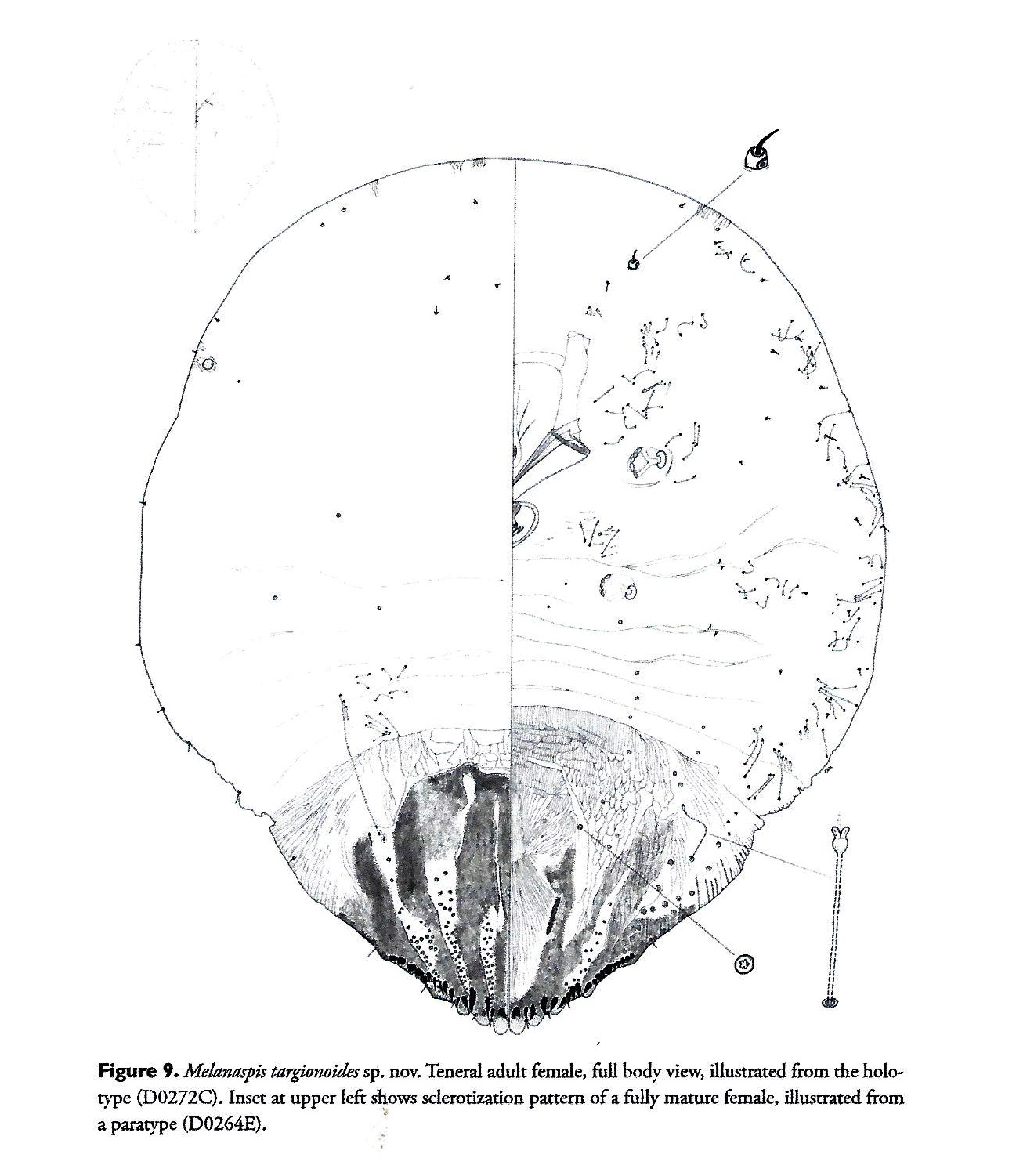Valid Names Results
Melanaspis targionoides Schneider, Claps, Wei, Normark & Normark, 2020 (Diaspididae: Melanaspis)Nomenclatural History
- Melanaspis sp. nov Gruwell, et al., 2005. unavailable name that is placed
- Melanaspis sp. undesc Gruwell, et al. 2009. unavailable name that is placed
- Melanaspis ud0276 Schneider, et al., 2018. unavailable name that is placed
- Melanaspis targionoides Schneider, Claps, Wei, Normark & Normark 2020: 62. Type data: ARGENTINA: Jujuy, entre Maimará & Tilcara; (23.586S, 65.408W); 2/13/2002; by L. E. Claps, P. Zamudio, L. Diaz-Briz, & P. Cabrera. Holotype, female, by original designation Type depository: Amherst: University of Massachusetts Entomology Collection; Tucuman: Fundacion e Instituto Miguel Lillo, Universidade Nactional de Tucuman, Argentina; Washington: United States National Entomological Collection, U.S. National Museum of Natural History, District of Columbia, USA; accepted valid name Notes: Paratypes: Argentina • 1 adult female; same data as holotype; UMEC (D0272E) • 1 adult female; same data as holotype; UMEC (D0272F) • 4 adult females; Jujuy, Humahuaca, camino a Aparzo; 23.20S, 65,10W; 13.II.2002; L. E. Claps, P. Zamudio, L. Diaz-Briz, & P. Cabrera leg.; USNM, L. E. Claps catalog #23-02 (D0264D) Illustr.
Common Names
Ecological Associates
Geographic Distribution
Countries: 1
- Argentina
- Jujuy | SchneiClWe2020
Keys
- SchneiClWe2020: pp.67-71 ( Adult (F) ) [Aspidiotini in Argentina]
Remarks
- Systematics: http://zoobank.org/2416C2B7-1A4F-40E7-BEE3-18536816FF23 Several DNA sequences of Melanaspis targionoides sp. nov. have been published, including fragments of 3 loci from the holotype (D0272C): large ribosomal subunit (28S, GenBank accession number KY218986.1), elongation factor 1-alpha (EF-1α, MH915711.1), and carbamoylphosphate synthetase (CAD, MH915986.1). DNA sequences of the primary bacterial endosymbiont, Uzinura diaspidicola, of M. targionoides sp. nov. have also been published, including a fragment of the small ribosomal subunit (16S) of a paratype (D0264C, KY220091.1) (Schneider, et al., 2020) Melanaspis targionoides and Melanaspis lilloi are very similar. The two species are also distinguishable by DNA, and appear as separate clusters in published phylogenies (Morse and Normark 2006; Normark et al. 2019). Although the species are morphologically very similar, M. targionoides sp. nov. has more numerous and more sclerotized dorsal ducts, along with sclerotization of the prosoma at full maturity. Specifically, the two species may be distinguished by the following characters. In M. targionoides, the elongate cluster of dorsal ducts in the furrow of the first space (arising between L1 and L2) extends anteriorly at least 90% of the distance to the anus, its anterior end usually being directly lateral to the anus; in M. lilloi., this cluster of dorsal ducts extends only 60–85% of the distance to the anus, its anterior end always lying posterolateral to the anus. In M. targionoides the furrow of the third space (arising between L3 and L4) has a single or double line of conspicuous subcircular sclerotized duct orifices extending from near the posterior margin to the anterior third of the pygidium; in M. lilloi., the furrow of the third space has sclerotized duct openings only in the posterior third of the pygidium, with sometimes a few present further anteriorly along the medial edge of the furrow (lateral edge of the sclerotized area arising from L3) – these are often only partially sclerotized and anteroposteriorly compressed, thus appearing as partial ellipses rather than complete circles. M. targionoides . has the prosoma sclerotized at full maturity (body length greater than 1.4 mm); M. lilloi. has the prosoma membranous at full maturity. M. targionoides . sometimes has perivulvar pores; M. lilloi. lacks perivulvar pores.(Schneider, et al., 2020)
- Structure: Adult female presumed to secrete scale cover, not pupillarial. Appearance in life not recorded. Slide-mounted adult female 860–1720 (median 1130, holotype 1020) μm long, 730–1440 (median 960, holotype 860) μm wide; broadest near mesothorax. Body outline turbinate. Prosoma becoming sclerotized at full maturity (length > 1400 μm); derm otherwise membranous except for pygidium, which has characteristic dorsal sclerotized areas; sclerotization of these areas unusually heavy, such that paraphyses and basal scleroses of lobes difficult to discern clearly on some specimens. Antennae simple, each with 1 long seta. (Schneider, et al., 2020)
- General Remarks: Detailed description and illustration in Schneider, et al., 2020.
Illustrations
Citations
- AndersWuGr2010: phylogeny,
- GruwelMoNo2007: phylogenetics, 276
- GruwelVoPa2005: phylogenetics, 105, 109
- GruwelWuNo2009: Cardinium, 1055
- MorseNo2006: phylogeny, 340
- NormarOkMo2019: phylogeny, 26, S2
- RugmanAnMo2010: phylogeny, 33
- SchneiClWe2020: DNA, description, diagnosis, distribution, genebank, illustration, key, symbiont, taxonomy, 62-67, 69
- SchneiOkNo2018: phylogenetics, 6



